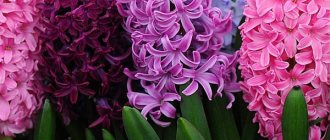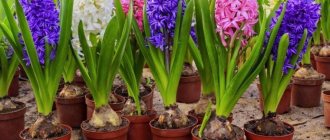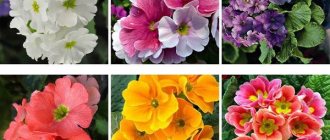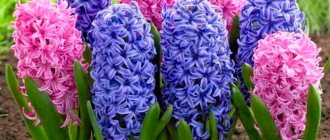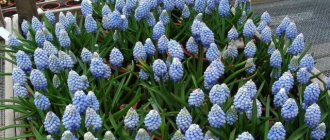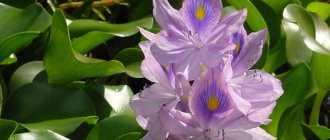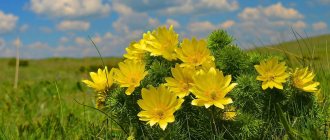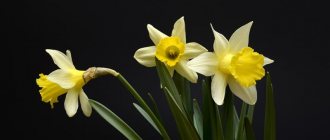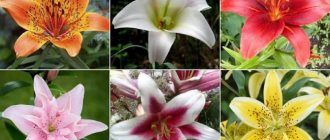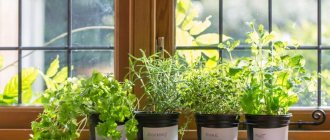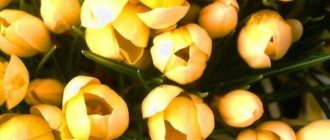Hyacinth is a garden flower, but it is also successfully grown in pots. Hyacinth in a pot is a bright decorative flower that appears in stores on the eve of the winter and spring holidays. Manufacturers often advise treating such a plant as a living bouquet. That is, just throw away the bulb after flowering. However, this is not the only option.
We will talk about planting and caring for hyacinth in a pot at home and how to preserve the bulb in order to achieve repeated flowering next year.
How to choose the right one?
Before purchasing a potted plant in a store, determine the purpose of purchase .
If hyacinth is needed only for a gift, pay attention exclusively to the density of the brush, the number and beauty of the buds, and the straightness of the peduncle. The synchronicity of flower blooming and the condition of the upper and lower tiers of the cluster are assessed to ensure long-term flowering.
What to pay attention to if you need planting material:
- the upper part of the bulb rises above the ground;
- there is no damage, defects or rot on the bulb;
- the peduncle is slender, straight, without curvature;
- leaves are fresh, green, fleshy;
- The plant stands upright in the pot and does not fall on its side.
If the bulb, stem, or leaves show signs of rotting, wilting, drying out, damage or fungal infection, you should not buy such a plant, even at the lowest price.
What soil to use
Planted in soil mixture
Advantages of using sand:
- Sand is preferred because bulbous plants do not need nutritional supplements during forcing.
- During the growing season, the plant uses the nutrients stored in the bulb.
- There are enough nutrients to form good buds and flowers.
- Sand is good because it does not pose a threat of infection with fungal diseases.
- Hyacinths grown in sand are very clean and presentable. There is no fungal plaque that reduces aesthetic perception.
Three stages of development
The bulbous perennial hyacinth cyclically goes through three phases of development throughout the year:
- In spring, the bulb “wakes up” - leaves grow, a peduncle emerges, and buds bloom. Under natural conditions, flowering occurs in March-May, which is determined by the variety. The growing season lasts approximately 3 months (March, April, May).
- By summer, the plant fades, and seed pods form on the peduncle. The leaves remain green in June. The bulb stores nutrients through its leaves for future growth and prepares for a long rest. The transitional phase of accumulation of reserves and transition to dormancy falls in June. Until the end of June, the onion is dug up for storage.
- At the end of September/beginning of October, the bulb is planted in the soil. The long stage of winter dormancy begins. The bulb will “sleep” in the soil all winter and come to life again in the spring.
In stores for the holidays, hyacinths are sold after forcing - an artificial displacement of natural biorhythms for flowering within a given time frame. The potted plant is weakened after forcing and needs special care .
Description
Indoor hyacinth has dense bulbs, complemented by succulent lower leaves, turning into a flowering stem (length up to 35 centimeters). After flowering, almost the entire above-ground part dries out. A bud remains near the very edge of the top leaf. It is she who will bloom next year.
Hyacinth in a flower arrangement
Other leaves can also be supplemented with small bulbs. As a rule, they are very weak, but quite suitable for cultivation (meaning vegetative propagation).
Hyacinth flowers are very showy. The inflorescences are racemose, resembling an oblong cone in shape. The perianth is represented by a bell-shaped funnel with slightly bent blades.
The hyacinth flower is rich in shades and tones: from neutral white to rich red. Both simple varieties and terry-type varieties are popular. The fruit of the “rain flower” contains two seeds surrounded by a soft, fleshy peel.
Hyacinth in the country
Actions after purchase
The desired container with a good, healthy flower was purchased and safely delivered home. The duration of the current flowering and the possibility of reusing the bulb depend on the correct home care.
Do I need to replant?
As a rule, the plant is brought from the store in a small pot with a small amount of substrate.
Hyacinth should be watered regularly during the flowering period; water should not get on the bulb; moisture should not stagnate. It is better to pour water into the pan.
A cramped store container will not be able to ensure normal moisture circulation.
The soil of the purchased plant in a pot is very poor and poor in mineral elements. Hyacinth will suffer from lack of nutrients. Therefore, a transplant is needed so that the hyacinth feels comfortable, blooms beautifully and makes a good reserve for the future.
Which container should you choose?
Choose a pot for transferring hyacinth, following the recommendations:
- A plastic, clay, ceramic pot is suitable;
- the main condition is the presence of drainage holes at the bottom;
- container size – depth 15 cm, diameter 9 cm for one onion;
- a drainage layer of fine expanded clay is poured onto the bottom, and a layer of clean sand on top;
- Loose, light, non-acidic soil, purchased specifically for bulbous plants, is placed on the drainage.
Drainage is extremely important for hyacinth; stagnation of water provokes rotting and death of the bulb .
Planting in another container
It is very important to carefully transfer the bulb along with a lump of earth into a new spacious container. This process is called transshipment. It is necessary to preserve the root system and rosette at the base of the bulb as much as possible.
Transshipment is done in one confident movement , preventing the root ball from scattering and exposing the roots. Sprinkle soil on top, leaving the top third of the bulb free. Spray the soil once with a weak solution of an antifungal agent.
Preparing the pot
The growing container must be at least 1.5 times the size of the planting material. Holes are needed in the bottom of the container to allow oxygen to circulate in the soil. When choosing a container, it is worth considering the number of bulbs. So, if this is a single planting, a pot 15 cm high and with a diameter slightly larger than the planting material will do.
If you want to grow several specimens in one container, you must take into account that the bulbs should not come into contact with the walls of the container, and maintain a distance of at least 2 cm between them. Before using the pot for its intended purpose, it must be disinfected - doused with boiling water (if the material allows) or rinsed with a pink solution of potassium permanganate . Then a drainage layer about 5 cm thick of coarse sand, pebbles, small crushed stone, etc. is laid on the bottom of the dry container.
Did you know? According to legend, hyacinth got its name from the Greek god Apollo. At the site of the death of his favorite Hyakinthos, this beautiful flower grew.
Growing conditions at home
A hyacinth transplanted into a spacious pot needs watering, fertilizing, lighting and maintaining temperature and humidity conditions.
Lighting and location
The best place for blooming hyacinth in an apartment is a well-lit eastern or southeastern window sill. The lack of natural light is compensated with a fluorescent lamp .
The total time a flowering plant spends in the light should approach 15 hours per day.
The perennial will like it on a cool but insulated loggia or balcony . However, the flower does not tolerate direct sunlight. In this case, shading and periodically turning the plant with different sides towards the light are required. Otherwise, the peduncle will tilt to one side.
Protect hyacinth from drafts and sudden temperature changes. It is highly undesirable to place hyacinth near heating devices (radiators, radiators, stoves).
The faded hyacinth is gradually reduced in lighting and moved to the north side. They are completely removed from the light when the leaves and stem have withered and the bulb has stocked up.
Temperature
The plant loves coolness, constant temperature without changes . The optimal flowering temperature for hyacinth is 16-18oC. This regime will prolong flowering up to 4 weeks. If you leave hyacinth at 20-22oC, the flowering period will be reduced to 2-3 weeks.
Air humidity
During the flowering period, hyacinth needs a humidity of 80%. If the air in the apartment is dried by heating radiators, it is worth buying a special humidifier or periodically spraying water from a spray bottle. At the same time, moisture should not get on the flower itself. Daily wet cleaning will help maintain a comfortable microclimate in the room.
Watering and fertilizing
The flowering period requires daily watering of the plant with settled or melt water at room temperature. The watering technique consists of uniformly moistening the substrate, avoiding water getting on the bulb and peduncle. The best solution is for the plant to absorb water from the pan. After flowering, water much less often, wait for the leaves to wilt and stop moisturizing completely.
Feeding for hyacinth:
- when the first leaves appear - calcium nitrate;
- when releasing a peduncle - with a special mineral fertilizer;
- after flowering - superphosphate.
Fertilizing is especially necessary for indoor and potted plants to form a high-quality peduncle for the next season.
Lighting
Hyacinth in a pot, just like hyacinth in the garden, loves sunlight, but not the burning rays of the sun. If the duration of the daylight period is 12-15 hours a day, then the plant will delight others with its beauty. Moreover, it does not matter at all whether it is artificial or natural lighting.
If you create the right lighting, the plant will delight others with its beauty for a long time.
How long does it bloom at home?
The lifespan of one bulb can reach 10 years with proper care and periodic planting in open ground.
The flowering period is regulated by temperature. Coolness from 15 to 17oC will stop the wilting process and prolong the life of the inflorescences. A moderately warm atmosphere of 20-22oC will speed up the opening of buds and shorten the flowering period.
Origin
The homeland of hyacinths is the vast majority of the territories of the East and North Africa. However, it was Holland that especially popularized the flower. This country is often called the “hyacinth center”. In the Netherlands, breeders work tirelessly to create amazing new varieties, and the export of the best bulbs reaches colossal proportions.
Bouquet of hyacinths in the interior
The country's mild and humid climate made it possible to grow these flowers without much effort. Back in the 17th century, enterprising Dutch began mass cultivation of hyacinths and other bulbous perennials on an industrial scale.
Black hyacinths
How to care for different stages of development?
The technique for caring for home bulbous primrose varies depending on the phase of plant development.
During the rest period
The dormant period for a house plant replaces winter . Conditions are created that are close to the natural environment. The onion planted in the pot is covered with a paper cap and placed on the bottom shelf of the refrigerator for storage. Check periodically, moisturize, not allowing it to dry out.
The appearance of a sprout up to 5 cm in size means the arrival of spring. The plant is moved to a warmer room, to a closed balcony, for example, to give access to lighting. As soon as the first buds form, the hyacinth is brought into the home and placed on the windowsill.
During bud formation
During flowering, care involves maintaining optimal levels of cool temperature and humidity. Adjust the illumination with a special lamp. Intensely flowering hyacinth is fed with mineral fertilizers. Protect from heat, direct sunlight and drafts, temperature changes, and stagnant water.
What to do next when the flowers have faded?
When the perennial has faded, proceed as follows::
- remove the peduncle;
- until the leaves wither, continue to water, but do it much less often;
- move the pot with fading flowers to a less sunny side;
- before the end of June, the onion is removed from the soil, cleaned, and the tops are cut off;
- dry for 3 days at room temperature;
- placed on the bottom of a box with holes and a bottom lined with paper;
- cover with paper or dark, breathable fabric;
- June, July keep the bulb at a temperature of 25-27oC away from light and moisture;
- in August, lower the storage temperature to 17oC;
- in mid/late September the bulb is planted back into the ground.
It is not recommended to drive out one bulb twice in a row. Periodically planting it from a pot into open ground will extend the life of the bulb.
Characteristics of hyacinth
Hyacinth is a herbaceous bulbous perennial from the Asparagus family. Grows from 20 to 40 cm. The leaves are succulent, linear - from 4 to 8 pieces in a basal rosette. The buds are collected in a cluster (sultan) on a fleshy, thick peduncle. The flowers look like bells. As they open, the petals arch. The bulb can be round or cone-shaped - the average diameter is about 6 cm. The color of future flowers is determined by the color of the outer scales:
- purple bulb - blue, violet or blue flowers;
- lilac - pink, crimson, light gray;
- brown - yellow, beige, peach, scarlet, orange.
Regardless of where hyacinth grows - at home in a pot or in a garden - it blooms once per season, for 10-14 days. With good care and optimal conditions - up to 25 days.
Reproduction
There are several methods for propagating hyacinths:
- seeds – used in breeding work;
- leaves - a labor-intensive, inconvenient and unpopular method;
- by children - separated from the mother bulb, planted separately, plants are obtained from the second year;
- bulbs - initially using purchased material, this is the most common and affordable method;
- By cutting out the bottom of the bulb, a large number of large, viable children are achieved. They are subsequently planted to produce new hyacinths.
Gardeners recognize the method of cutting out the bottom of the bulb as the most promising and fastest . The method is relatively simple and accessible even to inexperienced gardeners.
Species diversity
Varieties of hyacinths are presented in such an impressive number that it is quite difficult to systematize them all. Previously it was believed that there are 30 species and 500 varieties of these amazing flowers.
Large-scale reorganization and changes in the principles of plant classification themselves caused many species to be transferred to another genus. Nowadays it is customary to call only three types of hyacinths:
- Oriental;
- Litvinov's Flower;
- Transcaspian.
These are the three main plants that are suitable for growing and breeding new varieties. It is virtually impossible to give an exact figure of how many varieties exist at the moment.
Hyacinths in a wooden flowerpot
Diseases and pests
Unfortunately, even house plants are susceptible to diseases and pest attacks:
- white rot of bulbs;
- gray rot;
- fusarium;
- onion mite;
- onion hoverfly;
- stem nematode.
The cause of fungal diseases and pest damage is improper watering, the use of contaminated soil or containers for planting. Diseases can be prevented by treating the bulbs with Hom before planting .
Sprinkling plants with a solution of colloidal sulfur will protect them from pests. A good prevention is to follow the rules for planting and caring for flowers.
Problems and mistakes in caring for indoor plants
Hyacinths are considered quite capricious and demanding to care for.
It is not surprising that both beginners and experienced gardeners make a number of mistakes that lead to negative consequences. Most common problems :
- rotting of the plant - lack of drainage, water gets on the bulb or stem when watering;
- weak flowering stem with small flowers – violation of the temperature regime of storage;
- pale flowers, loose, sparse cluster of inflorescences – lack of soil microelements;
- yellow leaves - drafts, high temperature;
- wilted leaf tips - insufficient lighting, dry air, no air circulation;
- the peduncle is tilted to one side - uneven lighting;
- fracture of the peduncle under the weight of the inflorescences - the soil is too nutritious and moist, such an inflorescence can be supported;
- buds falling off - too hot or cold, draft, temperature difference;
- dried leaves mean hard water for irrigation; instead, you should use settled or melt water.
The rapid wilting of hyacinth and the falling of collected buds may be a consequence of damage by aphids, nematodes, or mites. It is better to get rid of the infected specimen immediately , since it is unlikely to be revived.
Features of planting bulbs
Planting bulbs is slightly different, for example, from tulips, the bulbs are large enough and do not need to be buried deep.
It is enough to place them on the surface, they will take root and thus take root in the substrate.
For correct penetration:
- the bulb is covered one-third with substrate,
- lightly press into the ground without twisting,
- watered with water to compact.
Flower bulbs
Hyacinths love moisture.
Do not allow the soil to dry out under any circumstances. Hyacinth bulbs are distinguished by the absence of a protective skin, so they are very afraid of stagnant water and can rot.
